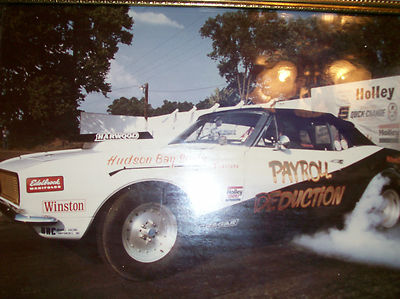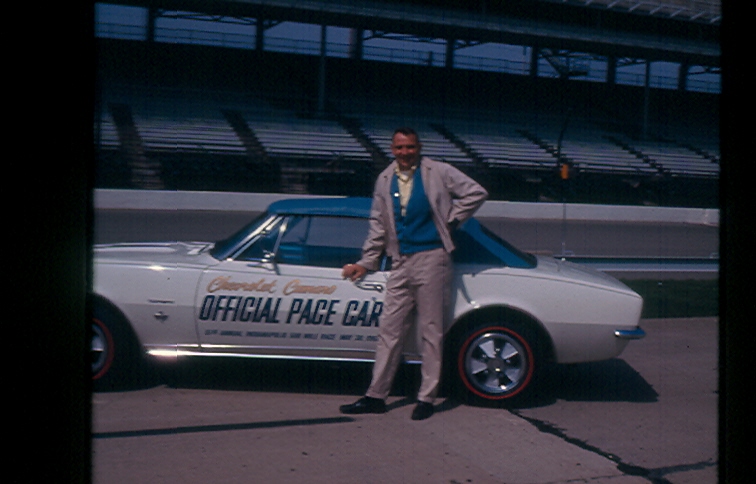
GM zone managers also recieved Pace Car Replicas, though it was understood that they were of the "O-1" or "O-4" color code and mostly were 396's. The Canadian Zone managers also got in the act and ordered their own Pace Car Replicas. 21 in all, which were produced the 3rd week of June. My car was produced the 3rd week of June, right in the middle of the Canadian batch of replicas according to their serial numvers and build dates.
It is believed that dealers created their own Pace Car Replicas buy ordering Ermine White Convertibles with deluxe blue interiors. They would then order the pace car door decals and install them.
For the latest and most accurate information, please go to CamaroPaceCars.Com.


The second owner, Raymond Morgan, completed the transformation of the car into drag car and raced it from approx 1972 - 1979. He ran it with a 468 Big Block Chevy, a turbo 400, 5.13 rearend gears and 32" tall tires. He raced in the NHRA super street and/or super gas series at Edgewater, Kil-kare, and Tri-State raceways all located in Ohio. In 1978 it was the NHRA Formula Stock Record holder for that area.
The following pictures show the various incarnations of the car from 1978 and earlier.
The fourth owner, Kenneth Lowden of Dayton Ohio, purchased the car on 9/20/2000. Based on the purchased price, it can be assumed that the car was fully intact at that time.
The fifth owner, Christopher Tucker of Towanda, NY purchased the car from Kenneth on March 30,2002 in Akron Ohio for $500. The purchase price implies that the engine and nose were stripped from the car before he bought it. It should be noted that Chris is known for his award winning restorations, which have appeared in Hemmings Muscle Car magazine. I'm not sure what it looked like when he got the car, but this is what it looked like when the fifth owner (Rick Hexemer) bought it and pulled it out of storage in 2006:
While in his possession Rick located a correct date coded 350 block with correct 1182 crank, heads, intake, carb and Muncie 4-spd transmission. All of these parts came with the car when I got it except for the transmission.
Unfortunately, Rick was unable to continue the restoration of the car and sold it off on e-bay. Here are some of the pictures from that auction. The pictures on the left show what it looked like when he first brought it home. The pictures on the right are what it looked like when he sold it.
When Dwayne started working on it, he posted a picture of it online. Here it is:
We first start with the trim Tag. Here it is with every indication that it has never been removed from the car:
The code in the top left corner indicates the month (06=June) and week (C=3) that the body was manufactured on. So knowing this one should expect the car to have late-67 features on it and all of the date coded parts should have dates no later then the 3rd week of June.
Too late to be a pace car replica by the way, since they were all built no later than May 67. It is interesting to note that there were some Canadian Festival cars that were pace car replicas built the same week as this car though. Unfortunately, the VINs are known on those cars and this isn't one of them......
To translate the code in the upper right corner you have to indentify the plant where the car was produced. This is appears on the tag as an NOR for the Norwood, Ohio plant. It would have read LOS if it was built in the Los Angeles/Van Nuys plant. This car was built at Norwood so the code R represents the interior paint code, which is Bright Blue. Otherwise, the code in that location would have been the body scheduling code for the Los Angeles plant.
The code next to "ST" tells you about the type (or style) of car it is. The first 2 characters "67" represents the model year (1967). The first 2 digits "12" after the "-" indicates the model type, which is Camaro. The 3rd digit "6" after the "-" indicates the interior style, which is Custom (it would be a 4 if it had a standard interior). The last 2 digits "67" after the "-" indicates the body type, which is a convertible (37 would be coupe).
So far so good, the car is obviously a 1967 Camaro Convertible with evidence of the dash and rear interior upper panels painted bright blue.
The code next to "TR" (for trim) tells you about the type of seats the car came with. "732" is the code for bright blue custom bucket seats. The "Z" indicates that the seats did not have head rests.
I didn't get the car with its original seats, but it did come with the correct style 1967 seats that can be reupholstered.
The code to the left of "PAINT" indicates exterior body color and top color (either Vinyl or Conv). On the this car the "C" indicates an Ermine White body color. Being a convertible the "4" indicates a blue convertible top. A blue top is kind of rare. Out of the 25,141 convertibles built that year only 1,346 came with a blue top.
It should be noted that a paint code of "O" indicates a special paint color. All Pace Car Replicas have an "O" though they were believed to have been paint Ermine White (code "C"). The "O" may be an indicator of the blue stripe that appeared on those cars. So, this car is not a Pace Car Replica simply based on the color code.
The remaining line of codes (when present) lists the car's major options. 1968-69 cowl tags do not have these codes and therefore makes it harder to identify whether installed options are factory or not.
Starting with the group 2 options, signified by the number "2" followed by the letters "LG", the letter "L" indicates a 4-speed floor shifter Regular Production Option (RPO) M20 and the "G" indicates a floor console (RPO D55). What specific transmission (Muncie or Saginaw) and what specific console type (with or without gauges) can only be determined by interpreting the remaining codes and examining the body if the original running gear is missing like this car. An examination of this car's body shows that the factory had drilled the holes for a speedometer cable that goes to a Muncie transmission. If the holes had not been drilled, then the transmission would have been a Saginaw 4-speed and the car would definitely have not been an SS-350.
The group 3 option, signified by the number "3" followed by the letter "L", indicates the RPO Z22 Rally Sport Package. The most noticable feature of this option is the hide-away headlights and the tail panel with integrated reverse lights mounted below the bumper.
And finally the group 4 option, signified by the number "4" followed by the letter "P", which indicates that the car was originally equiped with an SS-350 (RPO L48) or the 327ci-275HP w/ Saginaw 4-speed transmisison (RPO L30/M20). The only way to tell the difference (if the original running gear is missing like this car), is to examine the body. As previously stated the factory had drilled the holes for a speedometer cable that goes to a Muncie transmission, so therefore it is known that the car is an SS-350 (RPO L48) and that the transmission is a wide ratio Muncie 4 speed. Because of this, it is known that the console was equiped with gauges as part of the SS-350 option.It should be noted that Pace Car Repricas have a "4P-" on their tags.
So based on the cowl tag it is known that the car was originally a 1967 Camaro RS/SS Convertible, built during the 3rd week of June 1967 at the Norwood, Ohio plant. It was originally Ermine White, with a bright blue custom interior and a blue convertible top. It was equiped with hide-away headlights, an SS hood and a black nose stripe. It had a custom interior, a console with gauge and the seats were without headrests. It had a 350-295HP with a Muncie 4-speed transmission, traction bar (square) and a 12-bolt rear end.